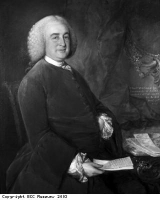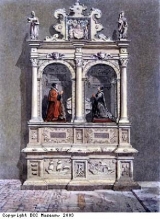Members of Parliament and businessmen
The merchants who invested in the slave trade had the support of Bristol’s Members of Parliament (MPs) for many years. The Bristol MPs were often men with an interest in the slave trade themselves. John Knight, Tory MP in 1679, invested in a sugar firm (the Tories then were the equivalent of today’s Conservatives). Sir Robert Cann, also MP in 1679, owned a sugar plantation in the Caribbean. Sir William Daines, MP from 1701 to 17109, was the son of a plantation owner in Virginia, in the southern states of America. Joseph Earle, Whig MP in 1715, invested in a slaving voyage (the Whig party was the equivalent of today’s Liberal Democratic Party). Sir Abraham Elton, Whig MP in 1722, had invested in slaving voyages and owned a brass works which supplied brass goods to many slaving ships (brassware made up a large part of the trade goods carried to exchange for slaves in Africa). Edward Southwell, elected Tory MP in 1739, 1741 and 1747, was married to a woman who had inherited money from her family’s Caribbean plantations. Such people had a personal interest in maintaining and extending the trade. Robert Nugent, pictured here, campaigned for free trade to Africa, and supported the City’s slaving interests as MP from 1754 to 1774.
Many of the city’s merchants were involved in the slave trade. Some only invested in one or two voyages and then gave up. Perhaps their voyages were not as profitable as they had hoped, and they returned to less risky voyages to the Mediterranean area of Europe and the Baltic region of northern Europe. Others were heavily involved. 53 Bristol merchants invested in 10 or more slaving voyages each. John Coghlan, one of the investors in the slave ship the Africa’s voyages of 1774 and 1776, invested in just 10 voyages. James Laroche invested in 132. Some of these merchants made a lot of money. Others, like James Rogers, with 51 voyages behind him, went bankrupt in the 1790s.
The merchants who invested in the slaving voyages helped to provide the labour, in the form of enslaved Africans, which produced the sugar and tobacco on the plantations in the Americas. These slave-produced goods were shipped back to Bristol by the slaving ships. Bristol merchants invested in the industries needed to transform the raw sugar and tobacco leaf into saleable goods. The first sugar refinery (or sugar house) was set up by Robert Aldworth in 1612. Aldworth was the richest Bristol merchant of his time, and his tomb in St Peter’s Church (now derelict) had sugar loaves carved on the base (a painting of his tomb can be seen here). The raw sugar that he imported into Bristol came from the islands of Madeira and the Azores. Sugar was not imported into Bristol from the Caribbean slave plantations until 1653. The second sugar house in Bristol was established in 1653 at the Great House on St Augustine’s Back (on the site of the present Colston Hall). The main investors were John Knight, his cousin Sir John Knight and Shershaw Cary. Sugar was an important part of the city’s 18th century wealth. At one point there were 20 sugar houses in the city, and there were many merchants involved in importing sugar from the Caribbean. The sugar refiners were important and influential men in Bristol. Many were involved in the politics of the city, and 16 of them became Mayor. Many had other business interests. Several went into banking, as partners in the many private banks which developed in the 18th century. Shown here is a banknote of the Bristol Bank for £30. The bank was founded in 1786: one of the original partners, George Daubeny, was a major sugar refiner in Bristol.
Many of the merchants who invested in the slave trade had other business interests as well. Merchant Noblett Ruddock managed 30 slaving voyages between 1712 and 1725. He also traded directly with Ireland and America, often shipping barrels of sugar and tobacco. Thomas Coster, merchant and MP for Bristol from 1734 to 1739, co-owned six slaving ships. He inherited property in the city, and brass works in Bristol, Wales and the Forest of Dean in Gloucestershire. Brass pots, pans and wire made up a large part of any slaving voyages trade goods. He thus not only owned the ships, he also supplied the trade goods.
Other residents of Bristol were investors in trading companies which were involved in the slave trade. William and Edward Colston, father and son, both merchants, were investors in the Royal African Company. This was a London-based company which for about 30 years until 1698 held control on British trade with Africa. It was obviously involved in the slave trade, as was another trading company called the South Sea Company. In 1713 Britain gained the licence, the asiento, to supply slaves to the Spanish-owned colonies in the Americas. The British government sold the asiento to the South Sea Company. This was a new company formed to trade with the Spanish empire. It became, for a short time, a fantastically profitable company. The contract to supply slaves to Spanish colonies was seen as an absolutely safe investment. Queen Anne, the writers Jonathan Swift and Daniel Defoe and Sir Isaac Newton all owned shares. One Mary Baker of Bristol owned £300 worth of South Sea Company shares when she died in 1739. Sir Abraham Elton and other Bristol merchants also bought shares. In 1720, the company’s share value rose astronomically, to the benefit of shareholders such as John Guy, a London bookseller. He owned a large number of shares, and sold as the value rose. With his profits he founded Guy’s Hospital in London. After the fast rise in share price, however, to £1,000 in June, there was a collapse and the shares were worth only £180 by September. The company survived this collapse, however, and continued trading until 1731.
Other companies might not have had such an obvious connection with the slave trade. Elizabeth Skrine of Bristol was a devout Christian belonging to the Anglican church who turned to another one, the Moravian Church, in the 1750s. She had shares in the East India Company, a trading company which had a monopoly control of British trade with India, China and Indonesia. It was famous chiefly for its tea imports from China. She may not have realised that the East India Company had had a short-lived but profitable interest in a slave trade run between Madagascar, an island off the east coast of Africa, and the Middle East and India. She may not have known, either, that the East India Company provided the European merchants with many Indian silk and cotton textiles which they used to trade in West Africa for slaves. As a devout Christian she was probably against the slave trade, but was unknowingly investing in it.





